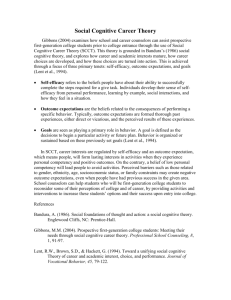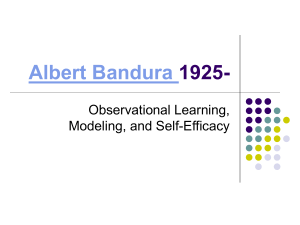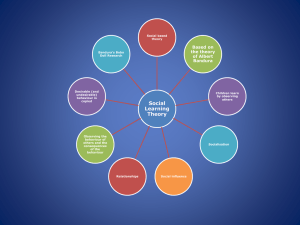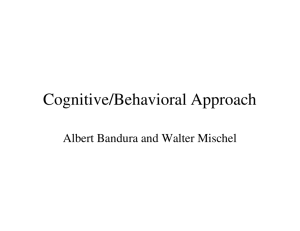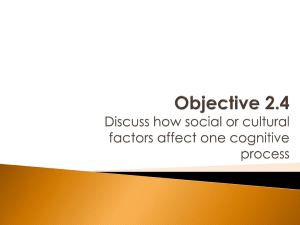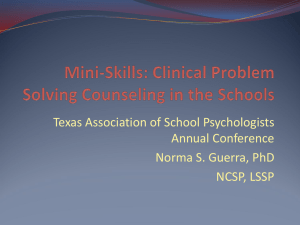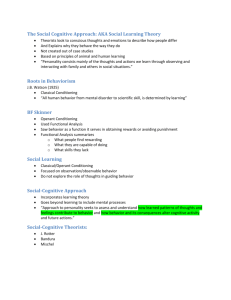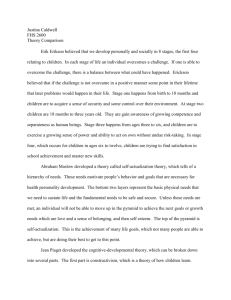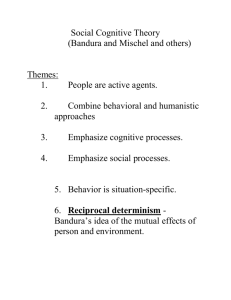Module 7. SOCIAL LEARNING THEORIES
advertisement
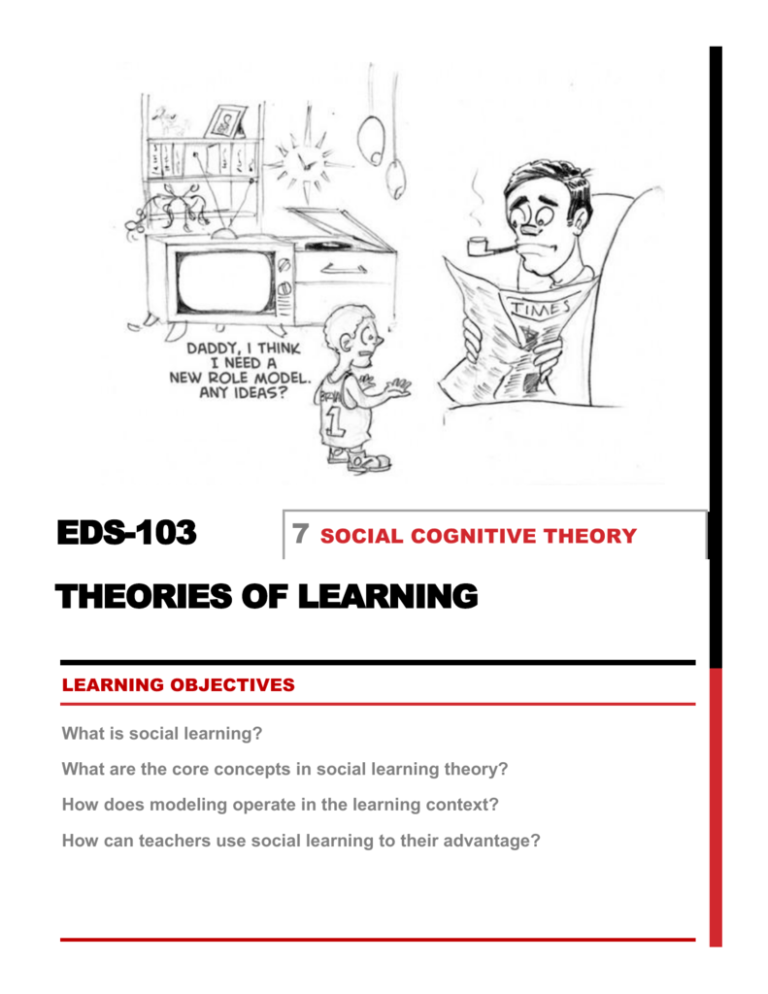
EDS-103 7 SOCIAL COGNITIVE THEORY THEORIES OF LEARNING LEARNING OBJECTIVES What is social learning? What are the core concepts in social learning theory? How does modeling operate in the learning context? How can teachers use social learning to their advantage? EDS 103 – Theories of Learning Module 7: Social Cognitive Theory EDS 103 - THEORIES OF LEARNING MODULE 7. SOCIAL COGNITIVE THEORY http://www.mindmatters.edu.au/ Social learning theory explains human behavior in terms of continuous reciprocal interaction between cognitive, behavioral, an environmental influences. Introduction Albert Bandura did not believe that direct reinforcement can explain all types of learning. He thus proposed the concept of social cognitive theory. A general contention is that much of the development in human cognition is explained by the interplay internal personal factors in the form of (1) cognitive, affective and biological events, (2) behavior, and (3) environmental events. People are viewed as having control over 'the motivational, affective, and social determinants of their intellectual functioning, as well as the cognitive aspects' (Bandura, 1993, p. 136). The social element in particular emphasizes that “people can learn new information and behaviors by watching other people, also known as observational learning or modeling” (Cherry, n.d.). Albert Bandura's social learning theory tries to explain how children model their behavior after those around them. This About.com video gives a quick overview about social learning theory. WATCH AND LISTEN TO ALBERT BANDURA kitomarketing.com A short introduction by the leading proponent of social learning theory. Lou Juachon, Ph.D. / UPOU 2 Module 7: Social Cognitive Theory EDS 103 – Theories of Learning kitomarketing.com A BOBO DOLL EXPERIMENT Does the violence that children observe on television, movies, and video games lead them to behavior aggressively? Watch the video Read the article at By Cherry About.com A SIMPLE EXAMPLE Baby Dancing to Beyonce http://www.holah.karoo.net/bobo2.JPG Given Bandura's Bobo Doll experiment, what do you think the role of the media is in the development of positive behavior? Violent behavior? Theoretically based television programs can be viable means of educating young children. Describe a TV "success story" that teaches children positive cognitive and social skills. (http://highered.mcgraw-hill.com) Social Cognitive Theory Concepts Social cognitive theory extends behaviorism and focuses on changes in behavior influenced by observing others (without the need for active participation). In addition to behavior and the environment, it also considers learners' beliefs and expectations. Social cognitive theory asserts that there is a variety of learning that cannot be fully explained by direct reinforcement. The theory further suggests that reinforcement and punishment affect learners' motivation, rather than directly cause behavior. An important element of the theory is, as you may have guessed, the social dimension—i.e., people can learn new information and behaviors through observation and modelling. (Schunk, 2012; Cherry, 2012) The social learning theory of Bandura emphasizes the importance of observing and modeling the behaviors, attitudes, and emotional reactions of others. Bandura (1977) states: "Learning would be exceedingly laborious, not to mention hazardous, if people had to rely solely on the effects of their own actions to inform them what to do. Fortunately, most human behavior is learned observationally through modeling: from observing others one forms an idea of how new behaviors are performed, and on later occasions this coded information serves as a guide for action." (p22). Social learning theory explains human behavior in terms of continuous reciprocal interaction between cognitive, behavioral, an environmental influences. Source: Richard Culatta (2012) http://www.instructionaldesign.org/theories/social-learning.html Lou Juachon, Ph.D. / UPOU 3 Module 6: Social Cognitive Theory EDS 103 – Theories of Learning MODELING: VICARIOUS LEARNING Modeling is a principal component of social cognitive theory, and vicarious learning occurs when people observe the consequences for others' actions and adjust their own behavior accordingly. Types of Modeling 1. Direct - from live models: actual individual demonstrating or acting out a behavior 2. Symbolic - from books, movies, and television: symbolic model, which involves real or fictional characters displaying behaviors in books, films, television programs, or online media 3. Synthesized - combining the acts of different models: e.g., verbal instructional model, involves descriptions and explanations of a behavior. Kendra Cherry (2012) http://psychology.about.com/od/developmentalpsychology/a/sociallearning.htm Modeling Outcomes Modeling can cause new behaviors, facilitate existing behaviors, change inhibitions, and arouse emotions. In learning from models, observers go through the processes of attention (observation), retention in memory, reproduction of the observed behavior, and motivation to produce the behavior in the future. Effectiveness of Models The effectiveness of models describes the likelihood of an observer's imitating a model's behavior and depends on perceived similarity, perceived status, and perceived competence. Because it encompasses attention, memory and motivation, social learning theory spans both cognitive and behavioral frameworks. Bandura's theory improves upon the strictly behavioral interpretation of modeling provided by Miller & Dollard (1941). Bandura’s work is related to the theories of Vygotsky and Lave which also emphasize the central role of social learning. Source: Richard Culatta (2012) http://www.instructionaldesign.org/theories/social-learning.html PRINCIPLES BEHIND SOCIAL LEARNING 1. The highest level of observational learning is achieved by first organizing and rehearsing the modeled behavior symbolically and then enacting it overtly. Coding modeled behavior into words, labels or images results in better retention than simply observing. 2. Individuals are more likely to adopt a modeled behavior if it results in outcomes they value. Lou Juachon, Ph.D. / UPOU 2 Module 6: Social Cognitive Theory EDS 103 – Theories of Learning 3. Individuals are more likely to adopt a modeled behavior if the model is similar to the observer and has admired status and the behavior has functional value. Source: Richard Culatta (2012) http://www.instructionaldesign.org/theories/social-learning.html 1. People can learn through observation. Observational Learning In his famous Bobo doll experiment, Bandura demonstrated that children learn and imitate behaviors they have observed in other people. The children in Bandura’s studies observed an adult acting violently toward a Bobo doll. When the children were later allowed to play in a room with the Bobo doll, they began to imitate the aggressive actions they had previously observed. Bandura identified three basic models of observational learning: a) A live model, which involves an actual individual demonstrating or acting out a behavior. b) A verbal instructional model, which involves descriptions and explanations of a behavior. c) A symbolic model, which involves real or fictional characters displaying behaviors in books, films, television programs, or online media. 2. Mental states are important to learning. Intrinsic Reinforcement Bandura noted that external, environmental reinforcement was not the only factor to influence learning and behavior. He described intrinsic reinforcement as a form of internal reward, such as pride, satisfaction, and a sense of accomplishment. This emphasis on internal thoughts and cognitions helps connect learning theories to cognitive developmental theories. While many textbooks place social learning theory with behavioral theories, Bandura himself describes his approach as a 'social cognitive theory.' 3. Learning does not necessarily lead to a change in behavior. While behaviorists believed that learning led to a permanent change in behavior, observational learning demonstrates that people can learn new information without demonstrating new behaviors. Lou Juachon, Ph.D. / UPOU 3 Module 6: Social Cognitive Theory EDS 103 – Theories of Learning MECHANICS OF SOCIAL LEARNING The Modeling Process: How does social learning occur? Not all observed behaviors are effectively learned. Factors involving both the model and the learner can play a role in whether social learning is successful. Certain requirements and steps must also be followed. The following steps are involved in the observational learning and modeling process: Kendra Cherry (2012) http://psychology.about.com/od/developmentalpsychology/a/sociallearning.htm Attention In order to learn, you need to be paying attention. Anything that detracts your attention is going to have a negative effect on observational learning. If the model interesting or there is a novel aspect to the situation, you are far more likely to dedicate your full attention to learning. Kendra Cherry (2012) http://psychology.about.com/od/developmentalpsychology/a/sociallearning.htm Attention is active perception. Learning cannot take place if the material to be learned is not paid attention to. Our senses are bombarded by a tremendous amount of information, but attention is a limited resource, hence, it is necessary to filter received information to allocate limited resource to the requirements of the task (Sternberg & Williams, 2009). http://spidergirl364.hubpages Retention The ability to store information is also an important part of the learning process. Retention can be affected by a number of factors, but the ability to pull up information later and act on it is vital to observational learning. Kendra Cherry (2012) http://psychology.about.com/od/developmentalpsychology/a/sociallearning.htm Successful social learning requires that the behavior observed must be remembered, so that at the appropriate opportunity the behavior can be reenacted. Active memory techniques, like recall and describe, can facilitate retention of observed behaviors (Sternberg & Williams, 2009). Lou Juachon, Ph.D. / UPOU 4 Module 6: Social Cognitive Theory EDS 103 – Theories of Learning Reproduction Not all observed behaviors are imitated (Sternberg & Williams, 2009). Once you have paid attention to the model and retained the information, it is time to actually perform the behavior you observed. Further practice of the learned behavior leads to improvement and skill advancement. Kendra Cherry (2012) http://psychology.about.com/od/developmentalpsychology/a/sociallearning.htm Motivation Motivation facilitates enactment of earned behavior. People, for instance, need a good reason to execute certain behaviors. Reinforcement can also contribute to motivated behavior (Sternberg & Williams, 2009). o Direct reinforcement – rewarding actual behavior o Vicarious reinforcement – observing another person rewarded for a particular behavior o Self-reinforcement – rewarding one’s self for desired behavior; aligns with selfregulation Finally, in order for observational learning to be successful, you have to be motivated to imitate the behavior that has been modeled. Reinforcement and punishment play an important role in motivation. While experiencing these motivators can be highly effective, so can observing other experience some type of reinforcement or punishment. For example, if you see another student rewarded with extra credit for being to class on time, you might start to show up a few minutes early each day. Kendra Cherry (2012) http://psychology.about.com/od/developmentalpsychology/a/sociallearning.htm Internalization and Self-regulation Internalization and self-regulation, though not indicated to be among the phases of social learning, signifies its ultimate goal. Self-regulation represents being in control of one’s own behavior. Internalization means the individual not only “sees” but also “takes in and owns” the observed behavior to make it a part of himself—he adapts it and integrates it into his system. Learners become self-regulated when they set learning goals on their own, monitor their progress toward the goals, and assess the effectiveness of their efforts (extent to which the goals are met). The theory helps explain events such as why teachers' describing their thought processes as they demonstrate skills is effective, and why students self-regulate achieve higher than peers who don't. Self-efficacy In addition to influencing other psychologists, Bandura's social learning theory has had important implication in the field of education. Today, both teachers and parents recognize the importance of modeling appropriate behaviors. Other classroom strategies such as encouraging children and building self-efficacy are also rooted in social learning theory. Kendra Cherry (2012) http://psychology.about.com/od/developmentalpsychology/a/sociallearning.htm Lou Juachon, Ph.D. / UPOU 2 Module 6: Social Cognitive Theory The concept of self-efficacy lies at the center of psychologist Albert Bandura’s social cognitive theory. Bandura’s theory emphasizes the role of observational learning, social experience, and reciprocal determinism in the development of personality. EDS 103 – Theories of Learning "If efficacy beliefs always reflected only what people can do routinely they would rarely fail but they would not set aspirations beyond their immediate reach nor mount the extra effort needed to surpass their ordinary performances." From Encyclopedia of Human Behavior, 1994. According to Bandura, a person’s attitudes, abilities, and cognitive skills comprise what is known as the self-system. This system plays a major role in how we perceive situations and how we behave in response to different situations. Self-efficacy plays is an essential part of this self-system. What Is Self-Efficacy? According to Albert Bandura, self-efficacy is "the belief in one’s capabilities to organize and execute the courses of action required to manage prospective situations." In other words, self-efficacy is a person’s belief in his or her ability to succeed in a particular situation. Bandura described these beliefs as determinants of how people think, behave, and feel (1994). Since Bandura published his seminal 1977 paper, "Self-Efficacy: Toward a Unifying Theory of Behavioral Change," the subject has become one of the most studied topics in psychology. Why has self-efficacy become such an important topic among psychologists and educators? As Bandura and other researchers have demonstrated, self-efficacy can have an impact on everything from psychological states to behavior to motivation. The Role of Self-Efficacy Virtually all people can identify goals they want to accomplish, things they would like to change, and things they would like to achieve. However, most people also realize that putting these plans into action is not quite so simple. Bandura and others have found that an individual’s self-efficacy plays a major role in how goals, tasks, and challenges are approached. People with a strong sense of self-efficacy: View challenging problems as tasks to be mastered Develop deeper interest in the activities in which they participate Form a stronger sense of commitment to their interests and activities Recover quickly from setbacks and disappointments People with a weak sense of self-efficacy: Avoid challenging tasks Believe that difficult tasks and situations are beyond their capabilities Focus on personal failings and negative outcomes Quickly lose confidence in personal abilities Lou Juachon, Ph.D. / UPOU 3 Module 6: Social Cognitive Theory EDS 103 – Theories of Learning Sources of Self-Efficacy How does self-efficacy develop? These beliefs begin to form in early childhood as children deal with a wide variety of experiences, tasks, and situations. However, the growth of selfefficacy does not end during youth, but continues to evolve throughout life as people acquire new skills, experiences, and understanding. According to Bandura, there are four major sources of self-efficacy. 1. Mastery Experiences "The most effective way of developing a strong sense of efficacy is through mastery experiences," Bandura explained. Performing a task successfully strengthens our sense of self-efficacy. However, failing to adequately deal with a task or challenge can undermine and weaken self-efficacy. 2. Social Modeling Witnessing other people successfully completing a task is another important source of self-efficacy. According to Bandura, "Seeing people similar to oneself succeed by sustained effort raises observers' beliefs that they too possess the capabilities master comparable activities to succeed." 3. Social Persuasion Bandura also asserted that people could be persuaded to believe that they have the skills and capabilities to succeed. Consider a time when someone said something positive and encouraging that helped you achieve a goal. Getting verbal encouragement from others helps people overcome self-doubt and instead focus on giving their best effort to the task at hand. 4. Psychological Responses Our own responses and emotional reactions to situations also play an important role in self-efficacy. Moods, emotional states, physical reactions, and stress levels can all impact how a person feels about their personal abilities in a particular situation. A person who becomes extremely nervous before speaking in public may develop a weak sense of self-efficacy in these situations. However, Bandura also notes "it is not the sheer intensity of emotional and physical reactions that is important but rather how they are perceived and interpreted." By learning how to minimize stress and elevate mood when facing difficult or challenging tasks, people can improve their sense of self-efficacy. Kendra Cherry (2012) http://psychology.about.com/od/theoriesofpersonality/a/self_efficacy.htm WILL YOU? Will you likely copy the behavior of someone unknown to you, one whom you disrespect or dislike? How would you like to behave like a person whose personality is so unlike yours? Won’t you tend to avoid doing a thing knowing that someone else has suffered adverse consequences from the deed? What behaviors are you likely to imitate? Lou Juachon, Ph.D. / UPOU 4 Module 6: Social Cognitive Theory EDS 103 – Theories of Learning WHAT CONSTITUTES GOOD MODELS FOR SOCIAL LEARNING? Sternberg & Williams, 2009, p. 261 FACTORS AFFECTING OBSERVATIONAL LEARNING AND PERFORMANCE Characteristic Developmental status Effects on Modeling Improvements with development include longer attention and increased capacity to process information, use strategies, compare performances with memorial representations, and adopt intrinsic motivators. Model prestige and competence Observers pay greater attention to competent, high-status models. Consequences of modeled behaviors convey information about functional value. Observers attempt to learn actions that they believe they will need to perform. Vicarious consequences Consequences to models convey information about behavioral appropriateness and probable outcomes of actions. Valued consequences motivate observers. Similarity in attributes or competence signals appropriateness and heightens motivation. Outcome expectations Observers are more likely to perform modeled actions which they believe are appropriate and will result in rewarding outcomes. Goal setting Observers are more likely to attend to models who demonstrate behaviors that help observers attain goals. Values Observers are more likely to attend to models who display behaviors that the observers believe are important and find self-satisfying. Self-efficacy Observers attend to models when they believe they are capable of learning or performing the modeled behavior. Observation of similar models affects self-efficacy (“If they can do it, I can too”). (Schunk, 2012, p. 134). Lou Juachon, Ph.D. / UPOU 5 Module 6: Social Cognitive Theory EDS 103 – Theories of Learning COGNITIVE BEHAVIOR MODIFICATION “The goal of education, in general, and cognitive-behavioral modification, in particular, is to encourage self-regulation in students” (Sternberg & Williams, 2009). Both cognitive and behavioral learning principles are used to generate desired behaviors; the combined use works better compared to the use of behavioral principles alone. The learner’s thoughts serve as the discriminative stimuli. This technique lends well to self-instruction, wherein the learner teaches himself. Meichenbaum (in Sternberg and Williams, 2009, p. 263) outlines the following steps for self-instruction: 1. Demonstration by model. 2. Modeling with overt adult guidance. - The learner then performs the same actions while talking aloud. At the same time, the model supervises the learner's performance. 3. Modeling with overt self-guidance. – The learner guides himself by instructing himself aloud (minus the guidance of the model). 4. Modeling with faded self-guidance. Like step 3, but now whispering the self-instructions rather than saying them aloud. 5. Modeling with covert self-guidance. Learner internalizes the behavior through inner speech (see Vygotsky’s social cognitive theory)—i.e., silently talking to himself. Application Application Social learning theory has been applied extensively to the understanding of aggression (Bandura, 1973) and psychological disorders, particularly in the context of behavior modification (Bandura, 1969). It is also the theoretical foundation for the technique of behavior modeling which is widely used in training programs. In recent years, Bandura has focused his work on the concept of self-efficacy in a variety of contexts (e.g., Bandura, 1997). Example The most common (and pervasive) examples of social learning situations are television commercials. Commercials suggest that drinking a certain beverage or using a particular hair shampoo will make us popular and win the admiration of attractive people. Depending upon the component processes involved (such as attention or motivation), we may model the behavior shown in the commercial and buy the product being advertised. Source: Richard Culatta (2012) http://www.instructionaldesign.org/theories/social-learning.html Professionals and business people who rose from poverty serve as role models and send strong messages about possibilities for success and move out of the niche of poverty. They are powerful symbolic models for promoting personal responsibility and pro-social values. Lou Juachon, Ph.D. / UPOU 6 Module 6: Social Cognitive Theory EDS 103 – Theories of Learning A MINI SURVEY OF TV PROGRAMS & ADS Examine a number of television programs. With social cognitive theory as your framework, what positive and negative effects can you identify? Consider various advertisements that use popular personalities as actors. Use principles from social cognitive theory to explain the choice of actors and the behaviors, events, situations, or consequences demonstrated in the ads. How do advertisements capitalize on social cognitive theory to market their products? Attempt to categorize programs, including advertisements, as appropriate or inappropriate for young children, regardless of the respective censorship ratings (e.g. MTRCB). Self-Assessment Answer the following to assess how well you have learned the unit. You need not post your answers, but you may want to raise questions or engage in discussion for clarification. EVERYDAY CASES Jun sees a guy about his age in a TV advertisement buying flowers for a girlfriend. The ad also shows the woman hug the man when he gives her the flowers. A day later, Jun buys a dozen roses for the girl he is courting. Provide a complete explanation for Jun's behavior, based on social cognitive theory. You are driving 65 on Commonwealth Ave, which has been marked speed limit of 60. You see a car that has been pulled over for an apparent traffic violation. You immediately apply the brakes and slow your own vehicle. Identify two concepts from social cognitive theory that are illustrated in this instance. Explain. EDUCATIONAL CASES Greg concludes, "I seem to have a feel for French," as he begins his homework. His teacher often compliments him on the high quality of his written work, and his effort has continually increased. Explain these incidents, using reciprocal causation as a basis for your explanation. Teachers who model persistence in problem-solving tasks have students who persist longer than teachers who don't (Zimmerman & Blotner, 1979). What form of modeling occurs in such situations? Which modeling function is best illustrated by the students' increased persistence? Explain. One group of students watched teachers successfully solve problems, a second group watched peers do the same, and a third saw no models. Which group successfully solved the most problems, and which solved the fewest? Explain. Lou Juachon, Ph.D. / UPOU 7 Module 6: Social Cognitive Theory EDS 103 – Theories of Learning Open Thread Discussions You may choose to answer only some of the questions, preferably according to what you deem to be representative of what you consider relevant and of practical value. 1. According to Bandura, three factors work together to produce learning: behavior, person (i.e., cognitive), and environment. Environmental factors influence behavior, behavior affects the environment, person/cognitive factors influence behavior, and the loop repeats over and over. Describe how reciprocal determination affects learning. Provide a "real world" classroom scenario that illustrates this cycle. 2. Analyze strategies for effectively using observational learning techniques in the classroom. Consider the relationship between classroom diversity and observational learning. How can we effectively use modeling to nurture students' learning? What impact does students' self-efficacy have on their behavior? 3. Summarize how modeling can be used to foster self-regulation in students. Describe the characteristics of an individual who is considered a high self-regulatory learner. Using Bandura's concept of self-regulatory learning, how might teachers help students take control of their own learning and behavior? What are the best practices teachers can use to help "dependent" students become more selfdirected and self-regulated? How can teachers enlist the help of families to foster self-regulation in their children? Discuss how some cultures might resist the idea of children becoming "self-regulated" learners? Source: http://highered.mcgraw-hill.com TEACHER TOM’S CLASS Teacher Tom has asked individual students in his class to give short presentations to the whole class. Mara, the first student to present, did a great job, and several students raised their hands to volunteer as the next presenter. The only glitches during Mara’s presentation were the repeated interruptions from another student, Jimmy. Tom finally had to send Jimmy to the hall for a time-out. After Mara, Tom called on Mark to present. Mark, however, became so nervous he couldn’t continue. After watching Mark’s experience, suddenly nobody else in class wanted to volunteer either. Tom, concerned about Mark’s self-esteem, later decided to try a different way to get Mark to share with the class. He asked Mark questions, starting with a simple one, and praising Mark’s answer. Soon, Mark was comfortable sharing information. What do you think are the subtle and overt things that Teacher Tom accomplishes in his classroom to make his management style effective? What are some ideas that you have for adapting behavior theories to your personality and classroom population? Describe a classroom situation in which using a time-out would be appropriate. Following a student time-out, what can a teacher do to try and prevent the student's problem behaviors from occurring in the future? How might a teacher unethically use time-outs? Adapted from Sternberg & William, 2009 Lou Juachon, Ph.D. / UPOU 8 Module 6: Social Cognitive Theory EDS 103 – Theories of Learning TEACHERS AND STUDENTS’ BEHAVIORS An important principle of Bandura's social cognitive theory is that exposure to positive role models can alter students' attitudes. How do you think a teacher's behavior and attitude in the classroom influences students' behaviors and attitudes? What kind of student behavior would you expect to find in a classroom with an authoritarian teacher? Authoritative teacher? Permissive teacher? REACHING FOR A GOAL: A SOCIAL COGNITIVE APPROACH Identify a goal and use a social cognitive approach to create plans to achieve that goal. You may want to post suggestions for your classmates to help refine each others’ plans. dreamstime.com Take note of the processes involved in social learning. Guide for your e-Journal For your e-journal entries, you may use the following as guides, but feel free to express other thoughts (and feelings) about learning as they have been stimulated by the topics in this chapter. Keep in mind that learning is very personal and your e -Journal should be reflective of those personal learning events. AN IMPORTANT BEHAVIOR In a distance learning environment, such as this course, what one particular behavior do you think is most important for learners to acquire? As a participant in this class, use social learning theories as basis to make recommendations on how students in distance learning can help other acquire this behavior. PORTFOLIO ACTIVITY: MODELS AND MENTORS IN MY LIFE Accomplish the portfolio-style activity. (< Models and Mentors in My Life.docx > is uploaded in the course site) Media Overview Of The Social Learning Theory by Albert Bandura. http://video.about.com/psychology/Overview-of-the-Social-Learning-Theory.htm A Bobo Doll Experiment. http://www.youtube.com/watch?v=Pr0OTCVtHbU&feature=related Baby dancing to Beyonce. http://www.youtube.com/watch?v=ikTxfIDYx6Q Lou Juachon, Ph.D. / UPOU 9 Module 6: Social Cognitive Theory EDS 103 – Theories of Learning Optional Web Destinations Albert Bandura: Bandura's theory, research, and background. http://www.emory.edu/EDUCATION/mfp/bandurabio.html Self-Efficacy: An extensive description of a wide range of topics related to self-efficacy. http://www.emory.edu/EDUCATION/mfp/self-efficacy.html Self-Regulatory Learning: Role of self-regulation in defining one's personality, goals, and worldview. http://www.edpsycinteractive.org/topics/conation/conation.html References Bandura, A. (1989). Social cognitive theory. In R. Vasta (Ed.), Annals of child development. Vol. 6. Six theories of child development (pp. 1-60). Greenwich, CT: JAI Press. Bandura, A. (1993). Perceived self-efficacy in cognitive development and functioning. Educational Psychologist, 28, 117-148. Bandura, A. (2000). Cultivate self-efficacy for personal and organizational effectiveness. In E. A. Locke (Ed.), Handbook of principles of organization behavior (pp. 120-136). Oxford, UK: Blackwell. http://www.des.emory.edu/mfp/Bandura2000.pdf Bandura, A., Caprara, G. V., Barbaranelli, C., Pastorelli, C., & Regalia, C. (2001). Sociocognitive selfregulatory mechanisms governing transgressive behavior. Journal of Personality and Social Psychology, 80, 125-135. http://www.des.emory.edu/mfp/Bandura2001JPSP.pdf Cherry, K. (2012). Bandura's Famous Experiment on Aggression. In About.com. http://psychology.about.com/od/classicpsychologystudies/a/bobo-doll-experiment.htm Cherry, K. (2012). Social Learning Theory: An Overview of Bandura's Social Learning Theory. In About.com. http://psychology.about.com/od/developmentalpsychology/a/sociallearning.htm Cherry, K. (2012). What Is Self-Efficacy? In About.com. http://psychology.about.com/od/theoriesofpersonality/a/self_efficacy.htm Dweck, C. S. (1986). 'Motivational processes affecting learning.' American Psychologist, 41(10), 10401048. Kearsley, G. (Aug 2012). Social Learning Theory (A. Bandura). The Theory into Practice Database. Retrieved from http://InstructionalDesign.org. http://www.instructionaldesign.org/theories/sociallearning.html Schunk, D.H.. (2012). Chapter 4. Social Cognitive Theory. In Learning theories: An educational perspective (6th ed., pp. 117-162). MA: Pearson. Sternberg, R. & Williams, W. M. (2009). Educational Psychology. Pearson. University of South Alabama Online Learning Laboratory. Social Learning Theory. http://www.southalabama.edu/oll/mobile/theory_workbook/social_learning_theory.htm Lou Juachon, Ph.D. / UPOU 10
